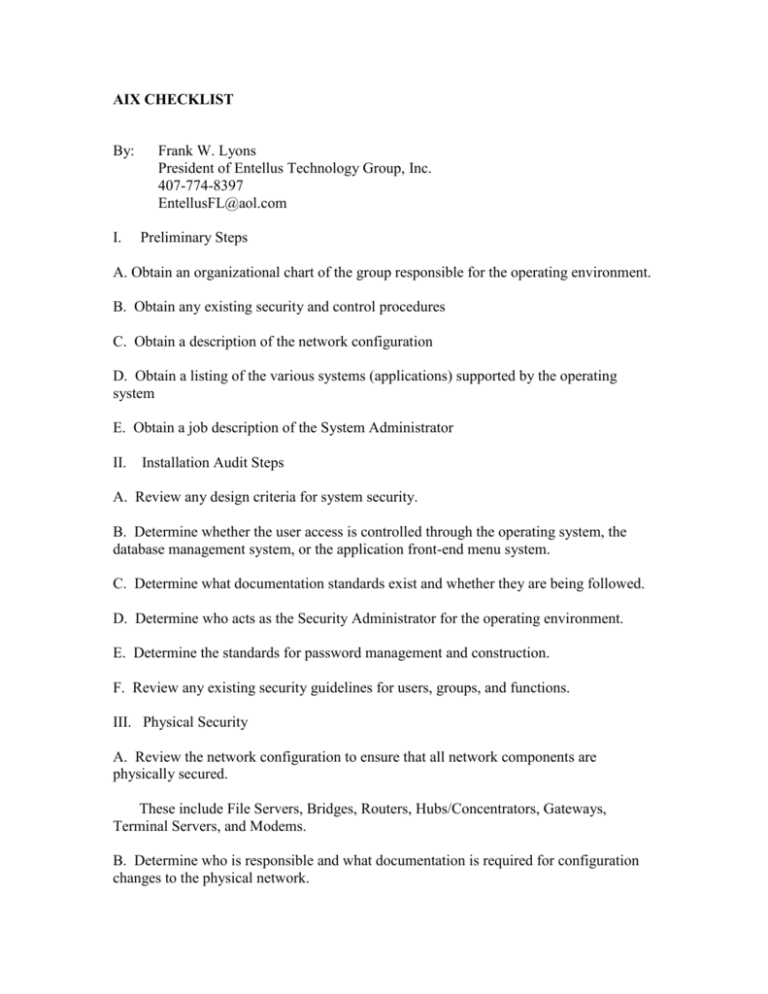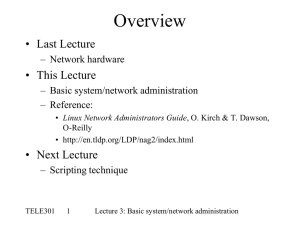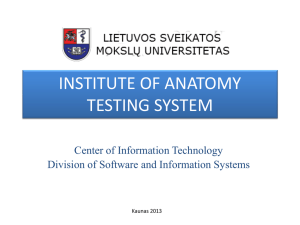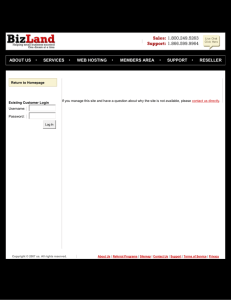aix checklist - Repository Root Me
advertisement

AIX CHECKLIST
By:
I.
Frank W. Lyons
President of Entellus Technology Group, Inc.
407-774-8397
EntellusFL@aol.com
Preliminary Steps
A. Obtain an organizational chart of the group responsible for the operating environment.
B. Obtain any existing security and control procedures
C. Obtain a description of the network configuration
D. Obtain a listing of the various systems (applications) supported by the operating
system
E. Obtain a job description of the System Administrator
II.
Installation Audit Steps
A. Review any design criteria for system security.
B. Determine whether the user access is controlled through the operating system, the
database management system, or the application front-end menu system.
C. Determine what documentation standards exist and whether they are being followed.
D. Determine who acts as the Security Administrator for the operating environment.
E. Determine the standards for password management and construction.
F. Review any existing security guidelines for users, groups, and functions.
III. Physical Security
A. Review the network configuration to ensure that all network components are
physically secured.
These include File Servers, Bridges, Routers, Hubs/Concentrators, Gateways,
Terminal Servers, and Modems.
B. Determine who is responsible and what documentation is required for configuration
changes to the physical network.
Are these procedures effective?
Are the changes to the network documented?
Are users and other impacted parties properly notified?
C. Ensure that only the System Administrator or other authorized personnel have
physical access to the file server console as the system can be rebooted from the ‘A’ drive
and a new root password can be supplied.
IV.
System Administration
A. Identify all the System Administrators.
$grep :0: /etc/passwd
B. Determine that each administrator requires this level of authority.
C. Determine the change control procedures over changes to users, programs, menus,
authorities, user scripts, hardware and system software.
D. Determine that the proper person or group is responsible for monitoring the network
that support the file server.
E. Determine that the proper person or group is responsible for system shutdown and
backups.
F. Determine if the System Administrator is supported by a backup or at a minimum
their userid/password are kept in a secured location in case of an emergency.
G. Determine who is responsible for maintaining license agreements and if all
agreements are being met.
V. System Security
The System Administrator’s interface for the AIX system is the System Management
Interface Tool (smit).
You can invoke smit by keying smit at the operating system prompt.
A. During the initial installation did the System Administrator create audit check sum
files. These files will allow the Security Administrator to verify that no changes have
been made since the installation of the system.
The audit check sum files should contain a single-line entry for each file having the
following information: (See /etc/security/sysck.cfg)
field
acl
class
pathname
owner
group
mode
size
listed for devices
links
version
checksum
reflects the
symlinks
program
source
type
comments
contains both base and extended access control list data for the file
a logical group to which this file belongs
Absolute pathname
Ether symbolic or numeric ID
Either symbolic or numeric ID
Symbolic representation as displayed by the ls -l command
Size of the file in bytes. Major and minor numbers are
Number of hard links to pathname
Numeric value, reported by what(1).
File contents computed by a checksum algorithm. This field
slightest change to a file, even a single character.
Indicates whether the file has symbolic or hard links
the associated checking program
the source file for this file
the type of file
Producing these files should be a simple task. The resulting files should reside in a
secured directory.
Dynamic security routines should be run on a periodic basis to ensure that these
critical files have not be modified without proper approval.
B. Determine if the system is running in a secured (trusted) mode.
/etc/security/passwd
For the password file
A trusted environment formats the primary password file’s encrypted password
/etc/passwd to the /etc/security/passwd file and replaces the password field in the
/etc/passwd with an ‘!’.
In addition, it forces all user to use passwords, creates an audit ID number for each
user, sets the audit flag on for all existing users, and converts the at, batch, and crontab
files to use the submitter’s audit ID.
C. Determine if auditing has been enabled. Use the following file to look at defined
audit events:
/etc/security/audit/events
Determine if minimal set of auditable events is being recorded.
Auditing is enabled by entering /etc/audit start
Files used by Audit
/etc/security/audit/config
configuration information
/etc/security/audit/events
audit events of the system
/etc/security/audit/bincmds backend commands
/etc/security/audit/streamcmds
commands that process stream data
/etc/security/audit/objects
information about audited objects
D. Review the audit logs to determine if any unauthorized event has occurred.
E. Review the inittabs to ensure that only authorized entries are present and that access is
properly restricted.
$cat /etc/inittab
F. Review all the rc. scripts to ensure that only valid programs are executed within these
scripts.
G. Review the sulog to look for suspicious activity
H. Ensure that the system backup is done on a regular basis and that the backup files are
properly stored.
VI.
Account Security
In traditional HP-UX systems you can use the ls -l command to list off the permissions
for a directory or a file. On a secure(trusted) system you can use the lsacl command to
see what permissions are associated with a given file, and the chacl command to change
the access control lists of the file. ACLs are attached to files or directories to allow the
Security Administrator to assign discrete authority to individuals or groups.
A. Obtain a listing of all user accounts and verify that each user is still an active worker
on the system.
$cat /etc/passwd
Files associated with the user accounts:
/etc/security/ids
uid sequence number
/etc/security/logins.cfg
contains rules for password quality
/etc/group
group definitions
/etc/security/group
additional group information and flags
/etc/passwd
user account file
/etc/security/passwd encryption passwords
/etc/security/user
contains user extended attributes
/etc/security/environ contains environmental attributes for users
/etc/security/limits
contains file limits
/etc/security/failedlogin
contains an entry for every time a login fails
Also the AIX system has a file that contains a stanza for each user known to the
system. This can be obtained by using the following command and file:
$cat /etc/security/user
One other file that restricts the user is the /etc/security/limits file. This file contains the
following:
fsize
is the largest file a user can create
core
is the largest core file allowed in units of 512 bytes.
CPU
being killed.
data
is the maximum number of CPU-seconds a process is allowed before
is the largest data segment allowed, in units of 512 bytes.
stack is the maximum stack size a process is allowed
rss
is the maximum real memory size a process can acquire
B. Obtain a listing of all group accounts and verify that each user still needs to participate
in the defined group.
AIX CHECKLIST
The group file contains some pre-defined groups such as the following:
system
staff
bin
adm
uucp
mail
security
cron
printq
audit
ecs
nobody
usr
A. Review the access control permission on the critical system directories and files. In
addition, review the access control permissions on the application’s directories and files.
Example:
$ ls memos
-rwxrwxrwx 1 frank system 0635 01/12 memos
The chmod command can still be used to change the permissions for a file and should
only be used if the file has any ACLs.
If you execute a command such as
$aclget
$aclput
$acledit
gets the ACL for a file
sets the ACL for a file
combines aclget and aclput
B. Review the users or groups who have write authority into a directory or file.
C. Review the umask value for a 027. This is located in the /etc/profile and the user’s
.profile.
The /etc/profile is a file that is executed each time a user login to the system. The
umask variable is only one entry in this file. The PATH variable may also be listed. The
PATH variable should also be review to ensure that the path search is proper.
Another parameter for the /etc/profile within AIX is the following parameter:
TMOUT/TIMEOUT defines the time (in seconds) that a user can be idle before being
automatically logged out of the system. TMOUT is used by ksh
D. Review the system for setuid and setgid programs. Compare the list against a
certification list of authorized programs. Use the find command to look for these type of
programs especially root owned setuid or setgid programs.
$ find / -user root -perm -4000 -exec ls -l {} \;
This find command will list root owned setuid programs
$ find / -user root -perm -2000 -exec ls -l {} \;
This find command will list root owned setgid programs
E. Password Security
Check to ensure that all users have a password.
Check to ensure that all users are using the shadow password system.
Check to ensure that no user ID are duplicated.
Review all accounts with a UID of ‘0’
Determine if all users listed in the /etc/passwd are still valid.
Determine if the password aging criteria is adequate
Password aging is enabled by placing the necessary information in the
password field
Determine if all passwords are at least six characters long
Determine if all passwords are run against a ‘hacker dictionary’ before being accepted
initially or when
changed.
F. Pseudo-Accounts
Most UNIX systems have pseudo accounts that are not associated with an individual
user and do not need to have an interact login shell. Be sure that the password field is
properly protected by not allowing anyone to signon to these accounts. By placing an
‘NP’ for no password within the password field, these accounts cannot be signed onto.
Determine if accounts such as the following have been removed from the /etc/passwd
file:
date
who
sync
tty
Other entries must remain as pseudo users such as:
bin
daemon
adm
uucp
lp
hpdb
guest
nobody
lpd
G. Home Directories
Ensure that the user’s home directories and files are not writable by anyone except the
owner or root
Ensure that the .profile .cshrc, and .login files are not writable by anyone other than
the owner
Investigate and remove if possible the use of any .rhost files within the user’s home
directory
Ensure that .netrc file is not used as the it allows for the user to bypass the .login
authentication for remote login and even contains the user’s unencrypted password. If it
is used and is required it should not be read or writable by anyone other than it’s owner.
Ensure that root’s .profile has a proper PATH variable with no ‘dot’ as the first entry.
A good PATH
A bad PATH
PATH=/bin:/usr/bin:/etc
PATH=.:/bin:/usr/bin:/etc
H. User Stanza
The /etc/security/user file contains a stanza for each user known to the system plus a
default stanza.
The parameters controlled in this file are:
admin indicates whether the user is an administrator. If yes/true/always then only
root can
can this user’s attributes. The default is no.
daemon
defines whether this user can use the cron and SRC daemons.
expires specifies an expiration date for the user. The format is MMDDhhmmYY.
The default
is 0 indicating that the account well never expire.
login controls login from a local terminal. If you specify false here the userid is
locked for all locally attached terminals but might not be locked for remote access.
rlogin controls login from a remote terminal or port. It controls whether or not
this userid can be accessed remotely via the rlogin command. It does not prevent local
logins
telnet defines whether this userid can be remotely logged into with the telnet
command. If used in conjunction with login and rlogin a userid can be secured from
anybody logging into that userid, but it is not secured against the use of su.
su
command.
controls whether other users can switch to this account by using su
sugroups controls which groups can switch to this userid by using su. If an !
precedes the group name it denies access for that group. The ALL keyword means that
all groups have access (the default). A blank indicates the default, i.e. ALL
tpath indicates trusted path characteristics. Trusted path is part of the trusted
computer base which ensures that the user only access directories and files that are
considered safe.
ttys
defines the terminals that can be used. The full path name of the
terminal’s must be given.
AIX CHECKLIST
I. Security stanza
The following file contains security stanza parameters that apply to the whole
system and it provides some control over password quality:
/etc/security/login.cfg
Parameters for this file are as follows:
maxage/minage
password
defines the maximum/minimum age(in weeks) of a
maxrepeat
password
defines the number of times one character can be repeated in the
mindiff
minimum
compares the new password with the old one. mindiff is the
number of characters that must be different.
minother
password.
is the number of non-alphabetic characters required in the
maxlogins
The only
is the maximum number of locally logged in users at a given time.
valid parameters are 2, 32, and 0. Zero means an unlimited
number.
minalpha
is the number of alphabetic characters required in the password.
shells
defines the valid shells a user can access.
herald parameters for the initial screen display
VII. Network Security
A. Review the /etc/exports file to see which files can be mounted by another machine.
The /etc/exports file lists entries that consist of the path name of a file system
followed by a series of names of computers and names of groups of computers. To
identify the groups of computers list off the contents of the /etc/netgroup file.
Each one line entry should have two fields. The first is the name of the file system
being exported.
The second and subsequent name the system to which the file system can be
exported. If fewer than two fields are present, the file system can be shipped anywhere in
the world.
B. List the /etc/hosts.equiv file to verify the names of other computers that can allow
their users to signon to this host without providing a password.
Verify that each of these other hosts do not extend unauthorized privileges to another
user or node.
Another file associated with the trusted environment is the .rhost files which could
allow someone to provide any other user to access their authorities without a password.
AIX CHECKLIST
C. Determine if an administrative domain has been set up.
If so, verify that root is controlled on each local host otherwise someone can obtain
root authorities on any machine within the domain.
Verify that consistency is maintained for user name, uid, and gid among password
files in the domain.
Verify that consistency is maintained for group files on all machines within the
domain.
D. Verify permission settings on network control files
The following files should never be writable by public:
networks
Network names and their addresses
hosts
Network hosts and their addresses
hosts.equiv
Remote hosts allowed access equivalent to the local host
services
Services name database
exports
List of files systems being exported to NFS clients
protocols
Protocol name database
inetd.conf
Internet configuration file & TCP/IP services
netgroup
List of network-wide groups
.netrc
allows for the processing of rexec and ftp commands without manual
password
verification. (The .netrc file contains unencrypted password
information)
E. Review the use of UUCP
F. Review the use of anonymous ftp
G. Review the use of tftp
H. Modem security
Use of a smart card or some type of secured dial-back
Use of an additional password
Kept access list current
VIII. Device File Security
A. Check the /dev directory for special devices that do not have the proper permission
settings.
B. Ensure that all devices only reside within the /dev directory.
C. Ensure that access to device such as mem, kmem, and swap are properly protected.
D. Terminal ports on UNIX systems may be writable by anyone, so you can allow users
to communicate by using the write or talk programs. Only the owner should have read
permissions.
E. Ensure that an individual user does not own any device except for their terminal
device or local printer.
AIX CHECKLIST
IX.
Batch Jobs Security
A. Scheduled jobs within the UNIX environment are setup in a file called the crontabs.
This file has a one line entry for each job to be executed at a given time. This file,
especially the one owned by root, should be reviewed to ensure that only valid entries and
jobs are run.
B. Other jobs can be run with the at command. Determine if the at command is
restricted by reviewing a file called at.allow and at.deny
X. Log File
A. Using the last command you can review the last login attempts on the system
B. Use the /etc/wtmp to review connection session
$ fwtmp < /etc/wtmp
C. Review the /usr/adm/messages for “BAD” login attempts
D. Check to see if accounting is turned on
The accton turns on accounting
E. Displaying process accounting records
The acctcom will allow you to display records from any file containing process
accounting records
XI. Special Commands or Routines
A. sysck
Runs the grpck, usrck, and pwdck commands
B. grpck
This command verifies that all users listed as group members are
defined as users, that the
gid is unique, and that the group name is correctly
formed.
C. usrck
definition.
D. pwdck
The usrck command verifies many parameters of the userid
The pwdck command checks authentication stanzas in /etc/passwd and
/etc/security/passwd.
DEFINITIONS:
kernel
Is the piece of software that controls the computer and is often called the
operating system
shell
Is a command interpreter and a program such as sh, csh, ksh, rsh, and tsh
AIX uses the ksh.
driver
peripheral
Is a program that enables the kernel to communicate with a given type of
/dev/kmem
by the kernel
Is a special device file that allows access to the ram locations occupied
/
The root directory
/dev
The /dev directory contains the devices attached to UNIX
/bin
The /bin directory contains a small subset of HP-UX commands
/etc
The /etc directory contains many files including the passwd file
/tmp
The /tmp directory is used for temporary file storage
/etc/inittab
each terminal
Contains information about system run levels and also has a entry for
Example: 04:2:respawn:/etc/getty tty10
04
= id
2
= operating system level
respawn = action
/etc/getty = program to execute
/etc/rc
/etc/passwd
Defines actions taken during startup
Determines who can log into your system
root:r832uq8io3rt6:0:1:Root System Owner:/:/bin/sh
AIX uses a shadow passwd file in the /etc/security directory. With this
file the primary
passwd file would look like the following:
root:!:0:1:Root System Owner:/:/bin/ksh
/etc/group
Identifies the users that form a group
audit:*:25:frank,anne,katie,michaella
/etc/ttytype
A database of terminal types
.exrc
/etc/motd
Maps terminal characteristics and sets up key definitions
Contains the message of the day
F
DEFINITIONS:
/etc/profile
Execute automatically during the login process
.profile
Executes each time the user successfully logs in using the Bourne(sh),
Korn(ksh), or rsh
.kshrc
Korn shell script that supplements actions taken by the .profile file
permissions Everything in UNIX is treated like a file. That is a data file is a file, so is
a directory, so is
a terminal, so is a modem, and etc. Each of these is identified by the file
type. The file types
are:
d = directory
- = a data or program file
c = a character file
b = a block file
l = a symbolic link
p = a pipe or FIFO
You can obtain this information by running the ls -l command
$ ls -l memos
-rwxrwxrwx 1 frank audit
456 Jan 7 12:45
memos
The first digit is the file type
The second through the 10 digit are the permission
rwx
rwx
rwx
for owner which is frank
for group which is audit
for other which is not shown but represents authorities
for all other
chmod
chown
umask
crontab
Command to change the permissions on a file
Command to change the ownership of a file
Default permission levels for all new files created
Automate job processing. Each entry contains the following information:
minute
hour
dates
months
days
runstring
0-59
0-23
1-31
1-12
0-6 0=Sunday
specifies the command line or script file to execute
An entry of ‘*’ means all values for that entry
smit
defaults
System Management Interface Tool
Default values for the mkuser command and smit
etc/security/mkuser.default
default group in AIX is staff





